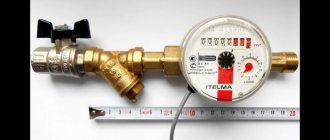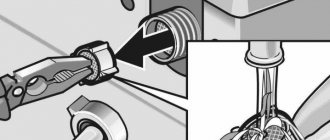How to check water meters yourself
How to check water meters yourself
In our country, as you know, there are standards for water consumption per person. It is against them that payments for water use are made every month. In reality, almost all of us consume much less than the prescribed amount. In order to find out how much resources were actually used, water meters are installed.
Water meters, like other metering devices, are sold after factory verification, but the technical passport that comes with the device clearly indicates the period when the next check needs to be carried out. Without it, the accuracy of the meter readings cannot be guaranteed, so there is nothing left but to check according to the current rules. This can be done in one of the following ways:
- dismantle the meter and provide it to metrologists;
- call specialists to your home who will check the device without removing it from the installation site.
Note! People prefer to check the meter “on the spot”. Firstly, it’s more convenient. Secondly, installation/dismantling procedures cost 200 rubles each, inspection costs 500 rubles, and re-commissioning costs another 500. A total of 1,400 rubles.
Quite a large amount, considering the fact that a new water meter costs the same. Therefore, we will talk about how to check the water meter yourself.
You may be interested in information - SVK 15g
Video - Checking water meters
Methods for checking water meters
The method for valuation is chosen by the owner, that is:
- he may choose the option in which the meter is checked directly at home, when no withdrawals are made;
- Carry out testing in laboratory conditions. In this case, the counter is dismantled.
Mostly, users prefer the first option, for which the corresponding deadlines and procedures are established in accordance with the Decree of the Government of the Russian Federation No. 354. There is also a by-law according to which the authorities of a particular region can set their own deadlines for conducting an inspection.
You can clarify the date of the subsequent inspection according to the agreement that was drawn up with the water supplying party.
When there are regional deviations from a legislative act, the agreement specifies a specific period for conducting inspections:
- For SGV they are four years:
- For other indicators – six years.
If amendments have not been made, then after the expiration of the specified time noted in specific documents, a check must be carried out.
For Metera, Itelma and some others they are four years and six years.
The term was increased to six years for Minol, Betar and Triton.
Some foreign-made water metering devices, such as Maddalena, can be checked once every ten to fifteen years.
If the meter does not pass the test within the specified period, it will be deregistered, and after ninety days the services will be calculated according to the general standards of the region.
Where are the documents sent after checking the water measuring equipment?
Before answering this question, it is necessary to understand the list of documents that the user should have in his hands. Let's look at the list of documents in more detail:
- device passport;
- delivery and acceptance certificate;
- certificate of verification.
The passport, which is attached to the flow meter, must contain the following information: date of manufacture, time of putting the device into operation, as well as the expiration date of the water meter.
The acceptance certificate must indicate the device number, installation date, data of the consumer and the management organization
The calibration certificate lists all the necessary data confirming the serviceability of the device. This act must contain the date of the inspection. In addition, it indicates the deadline for the re-check. Hot and cold water meters have different calibration intervals. It is these that the user should focus on when performing this operation again.
All of the above documentation must be sent to the managing organization. In addition, such issues are dealt with by the HOA, so you can register the metering device with this organization. The next step is to submit documents to the EIRC.
Order verification of water meters
Closer to the expiration date, the owner will need to submit an appeal either to the water supply company or to another organization that has the right to conduct similar activities.
You can simply use the phone number, by which you will need to provide the passport data for the device, namely:
- Name indicating the model;
- State registration number;
- Type;
- The address where the device is located;
- Full name and telephone information of the applicant.
If the workload of local foremen is light, the inspection can be carried out within ten days. Otherwise, the wait will last up to one month. More expensive, but can be quickly produced by employees of a third-party organization.
What is the price
All verification activities are paid at regional prices. On average, the cost of services is determined by the following values:
- the inspection itself - 400 - 800 rubles;
- filter cleaning - 200 - 300 rubles;
- installation of a seal - 100 - 150 rubles;
- inspection protocol - 200 - 300 rubles;
- meter replacement - 1800 - 2000 rubles;
- installation of a new meter - 2450 - 2600 rubles.
Thus, a check without replacing the meter will cost approximately 500-1500 rubles.
Accuracy of readings and their determination
The desired verification option is indicated when contacting:
- With dismantling;
- At home, without removing the device.
The first option is used less frequently, since it takes considerable time, when research in the laboratory can last up to one month. In this case, payment will be calculated based on the average value for the last six months.
When dismantling, you will definitely need to invite a plumber. When it is determined that the device is working properly, it will need to be both installed and sealed.
The convenience of the second option lies, first of all, in the absence of the need to carry out plumbing measures. The diagnosis takes about one hour. In this case, connected verification equipment is used. There is no need to pay based on the average value.
At the time appointed for verification, a contract is concluded, after which the control equipment most often used in these cases is connected.
Carrying out verification:
- From the system installation, the hose is connected to the mixer part at one end and to the control meter at the other. The outlet hose is inserted into the drain hole;
- The water is shut off by the valve. The data displayed on the device is recorded. The technician will need to ensure that the numerical readings do not change when closing;
- After opening the tap, a certain number of liters must pass through the controller to record data, which are compared through a reference device with the indicators shown by the meter.
If the error indicators are normal, then notes are made in the technical passport regarding the suitability for further use of the water meter, and documentation is also left:
- A copy of the agreement;
- Inspection report;
- Technical marked passport;
- Certificate of conformity;
- Receipt along with copies of documents establishing rights.
A significant error is accompanied by either:
- A proposal to install a new meter;
- Payment for services based on regional averages.
Features of a working device
It is worth knowing that a properly working water meter carries out its accounting activities according to the following principle:
Operating principle and design of a water meter
- If the water flows in a thin stream, then the device does not count the liters;
- If the water pressure is average, the bill is normal;
- If the water pressure is strong, the readings may be exaggerated.
Advantages and disadvantages
Pros:
- Saving money - even though the meter remains in place, it is impossible to break it. The cost of diagnostic work is from five hundred to a thousand rubles. You can lose more if distortions appear in the meter's operation;
- Saving time, since at home the test will take about one hour, and for a month of waiting for laboratory results you will have to pay at average prices.
The downside is the impossibility of conducting a detailed study of the device in order to accurately evaluate it technically. It may become unusable almost immediately after returning to its place, but you will have to pay for the verification procedure.
Who should pay
As a general rule, the responsibility for ensuring that the inspection is carried out lies with the consumer of the utility service! That is, on the owner of the residential premises. Accordingly, all financial costs associated with such a procedure are borne by the consumer.
Another version of the financial burden is possible only if the contract for the provision of utility services for the supply of cold and/or hot water contains provisions that the obligation to conduct a scheduled inspection lies with the service provider (its performer). In this case, all procedural and monetary issues must be resolved by the utility company.
Nuances
There are points that are worth considering:
- For many, it is more convenient to install a new water meter right away, so as not to have to pay for the monitoring procedure if faults are detected. After amendments are made to the technical regulations, the devices are made of durable metals and are able to pass inspection twice during their service life in eighty cases out of a hundred;
- You should not trust it to diagnose a water meter without prior information about the company, even if a threatening letter was found in your mailbox;
You should avoid overpaying. After completing the inspection, a copy of the title documents must be left. If it doesn’t happen, you will have to go through the procedure again and pay for it;
The installer's license may expire, so the resource provider should have all such information.
What to do if the device is lying?
If, after testing, a high error in the operation of the mechanism is diagnosed, the device requires verification in a metrological laboratory for suitability or replacement.
In this case, the following actions must be taken:
- Call a specialist by writing an application to a specialized company.
- Wait for him to remove the seal and dismantle the meter, having previously recorded readings from the device.
- Fix the problem in a metrology laboratory or purchase a new water meter.
- Invite a specialist and install a repaired or new device in the same place.
- Contact the management company by writing an application to register a water meter.
After installing the device, a second application is submitted to the company with a request to seal the water meter.
If you want to learn more about water meters, take a look at this section.
Photo instructions for checking water meters at home without removing them
Action algorithm
When checking the water meter at home, you will need to call a specialist to your home. First, an application is submitted to the metrological service. To be on the safe side, the procedure is performed in advance, because there may be a queue for the service. Based on such an application, a specialist with his equipment comes to the house and performs verification. Its essence is to pump water through a water meter and weigh it using high-precision scales.
Checking meters at home does not take much time
Stages of sequential verification:
- First, an application is submitted to the metrology center to call a specialist;
- The date and time of the professional’s arrival at your home is set;
- Before verification, an agreement on the provision of a paid service is concluded between the consumer and the center;
- Then payment for the service is made;
- Verification takes place in accordance with the contract, in which case the integrity of the meter is violated and the seal is removed;
- When the verification is completed, the client receives a conclusion, which will need to be taken to the service company.
If a document on checking the meter is submitted in a timely manner, the resident will not be fined. The verification algorithm is simple. The work gets done quite quickly.
Checking the meter at home is a paid service. Payment is made by the owner of the device.
First, special equipment is connected to the mixer. To do this, use a shower hose, but without a watering can. The output of the device is directed into a separate container. It is already installed on precise scales.
Before checking, it is necessary to shut off any other sources of water intake. Then the indicators of the device are recorded. Next, several liters of liquid are poured into the container. The water is weighed and converted into liters.
The resulting volume must be compared with the original meter readings. The procedure must be performed several times. As a result, all results are compared and the average is calculated. If the error is normal, the specialist confirms the serviceability of the meter. But if the error is large, then the device will need to be replaced.
On one's own
Not a single law or government regulation contains information prohibiting the installation of water meters on your own. But first you need to familiarize yourself with some nuances:
- What counters can be installed.
- Where should they be placed correctly?
- What documents reflect the rules for installing the device.
Meters that are included in the State Register of Measurements are allowed for installation. Information about the certificate must be indicated in the device passport, and the installation location in SNiPs. The greatest difficulty when installing devices without outside help is their registration with regulatory authorities.
The law states that the homeowner must put the device into operation no later than 15 working days from the date of submission of the application to the Criminal Code. If no one comes to inspect the device, a repeated application is written. If after another 15 days the employees of the executive organization have not appeared, then it is put into operation from the moment the first application is submitted.











